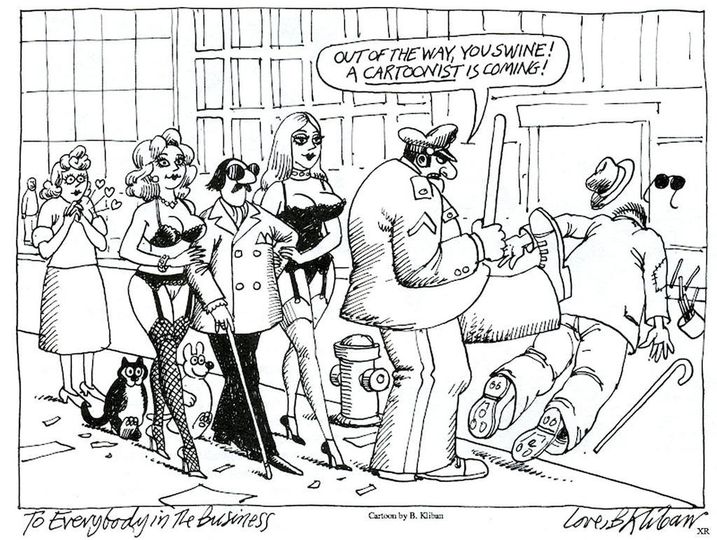CSotD: Several crises, one good solution
Skip to commentsHaving waded through the Coronation (mostly, see below), National Cartoonist’s Day, Cinco de Mayo and the Kent State Anniversary, we’re left with today’s demonstration of Wretched Excess, the Kentucky Derby.
Marc Murphy not only reminds us that Derby Day is a celebration of slavery but, in his comments, links to the author of an excellent analysis of Stephen Foster’s ode to the good old days of gay darkies longing for their places on the plantation, and the attempts over the years to clean it up so its meaning is not so obvious.
It’s important to note, as all these wealthy women put on their best Scarlett O’Hara hats and gowns, that this isn’t a sudden realization: The NAACP and others protested Gone With The Wind from the start, and, while Margaret Mitchell was defiant, David O. Selznick did attempt to nudge it away from its most offensive roots.
Meanwhile, the event all these folks primp and pose for has become harder and harder on horses overbred into fragility such that there’s always a good chance the Derby will include a death on the track. Five horses have already died this year in the lead-up to the big day.
What on earth are they celebrating?
Juxtaposition of the Day
Two final thoughts on the Coronation, with Megan Herbert in some way answering the question posed in Harry Bliss’s cartoon.
I doubt that Meghan is feeling any fear of missing out by staying home from the Big Event, though being uninvited is one more intentional slap in the face. However, they’ve had time to get used to things and we can hope that, by the time Will gets his turn to sit in the big chair, things will have mellowed out.
But Herbert’s cartoon also echoes a conversation I had yesterday, in which I said I’ve got nothing against Charlie, who seems like a good fellow, but I wish he’d met some nice American girl who might have deprogrammed him when, like Harry, he’d been young enough to see through the system.
But it’s not like very many of us have had the courage or the vision to step outside our minds and recalculate recalculate recalculate.
Meanwhile, out in the real world, there are more universal problems, many of them indeed caused by disinformation, and not always filtered through responsible journalism.
For instance, Gary Varvel (Counterpoint) passes on a mistaken interpretation of a shift in mortgage fees that has been so widely reported that I can’t blame him for getting it wrong, though he may have been too eager to seize upon it in order to criticize the Biden administration.
When Varvel posted this cartoon at Counterpoint, he included a note, something I wish more cartoonists would do more often:
President Biden is punishing people with a good credit score, by making them subsidize mortgage loans of higher-risk borrowers with bad credit. This sounds like the communistic philosophy: ‘From each according to his ability, to each according to his needs.”
Which is not entirely unprecedented, but that’s not the point now.
The point, rather, is that, if you searched Google News, that’s what you would find, but the sources for these reports nearly all came from the same side of the aisle.
It took significant digging to find actual analysis of the change. Politifact’s article included the above digest version, and Forbes had a good piece on the topic, but I don’t know if those were even available when Varvel penned his commentary; Snopes is still trying to figure it all out.
Even as someone who covered residential real estate for years, I had to really dig through the facts on this one, and I’m still unsure whether the original reporting was genuine confusion or deliberate disinformation.
But I’ve seen one report explaining that it’s Biden’s fault because he appointed the head of the agency that made the decision, which seems like a deliberate stretch. If nothing else, you can’t accuse him of micro-management at the same time you’re accusing him of senility.
And while I don’t expect cartoonists to understand the inner-math of mortgage financing, I do expect them to look into the current banking crisis more than Chip Bok (Creators) and a number of others have.
You needn’t approve of how the FDIC has stepped up to guarantee larger deposits, but you should grasp the fact that they’ve done it, and that the money used is furnished by member banks and not by taxpayers.
You should also recognize that the three banks that have failed were all in trouble at roughly the same time for the same reasons, and that the reforms made because of them are a reasonable, if not unassailable, protection against other banks falling apart now.
We’re currently at a point where, as FDR said of the Depression, the only thing we have to fear is fear itself. Specifically, banks can still be damaged by panic-inspired bank runs.
Thus you should recognize that this is a good time for everybody to be cool like little Fonzies, and a very bad time for cartoonists and commentators to be whipping up the aforementioned panic.
Kevin Siers seems to have a pretty good grasp of the looming debt crisis, though he offers a descending set of likelihoods:
The trillion-dollar coin dodge is pure sophomore-dorm-at-2-am theory, lovely if you haven’t thought things out and don’t actually know how the world works. In short, it ain’t gonna happen.
And there is, indeed, a clause in the Constitution requiring that we pay our debts, but it seems unlikely that the President could simply invoke it. It would likely have to go to the Supreme Court and, even assuming they’d take it on an emergency basis for a quick decision, the current court is something of a crap shoot.
Which leaves us with either default or cooperation, and cooperation requires that Kevin McCarthy gets the Crazy Caucus to fall into line, which may be as vain a hope as that trillion dollar coin.
One answer, and a good one
I can’t solve the debt crisis or the banking issues, but I’ve got a fix for Derby Day:
Cancel the race, which is only two minutes out of the day and kills the horses. Ditch the antebellum hats and gowns in favor of vintage bell-bottom jeans and gauzy floral blouses. And don’t fuss with fancy mint drinks. Just have cheap beer and crackling rosé on tap free in the grandstands.
And sing the new state anthem, not just at the start but as often as possible until y’all can’t:












Comments 13
Comments are closed.